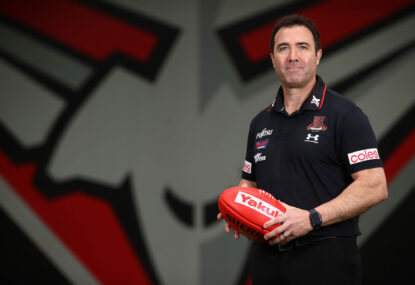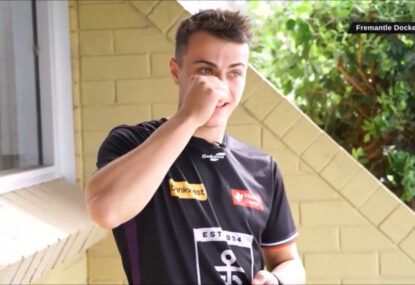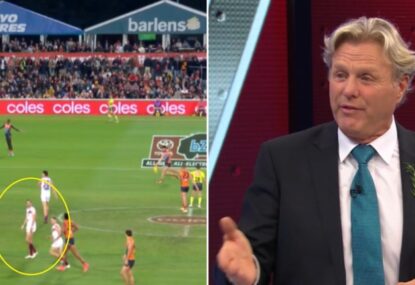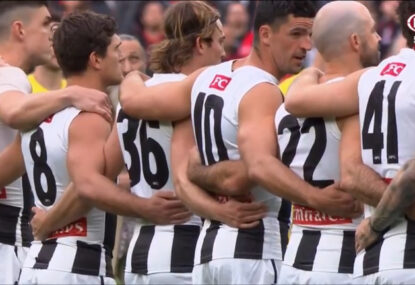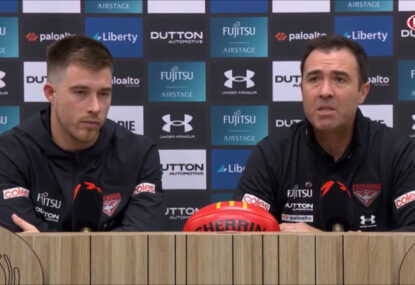In Part 1, I looked at how the individuals compared with each other after eight rounds.
Brisbane’s Hugh McCluggage has taken over the lead from Adelaide’s Taylor Walker, with two Bulldogs right behind them in Marcus Bontempelli and Jack Macrae.
Today in Part 2, we’ll use the ELO-Following Football ratings as well as several other tracking methods to compare the 18 AFL teams and determine what’s in store for the next few weeks.
This chart compares three things: the actual record after eight rounds, the expected record after nine rounds, and the current ELO-FF ratings for each team as of the start of Round 9.
The rating system we use at Following Football is considered an ELO system because, like the chess ratings that first used Arpad Elo’s zero-sum methods, the same amount that one team adds to its rating is subtracted from the others’.
The ratings compare outcomes with expectations. For example, because the ratings expected Geelong to win by 22.3 points on Friday night, and they won by 21, they actually underperformed very slightly – thus, one tenth of a point was subtracted from their 70.0 rating while one tenth was added to St Kilda’s 46.7 rating.
It’s slightly more complicated than that, but not much – and despite its relative simplicity, it’s at least as accurate as the vast majority of the systems crawling around the media and internet.
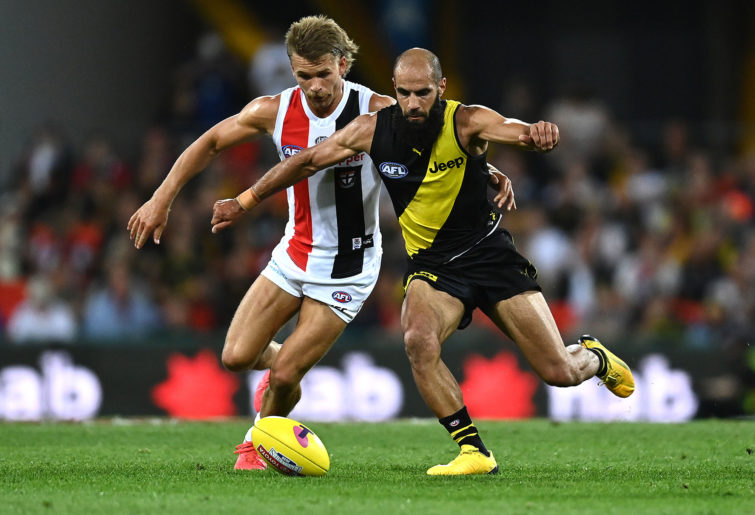
(Photo by Quinn Rooney/Getty Images)
That’s where the expected record comes in. We start with what the oddsmakers post on Monday morning, which is usually how they really think the game will play out. We’ll adjust that number by comparing all of the other methods and forecasts we track (including The Roar’s), and that’s the general expectation of the public for each game.
Enough explanation — here are the numbers.
1. Melbourne – 8-0-0, 145% after Round 8 – ELO-FF rating: 63.6 (fifth) – Expected record: 6-3-0 (121%).
2. Western Bulldogs – 7-1-0, 150% – ELO-FF rating: 70.7 (first) – Expected record: 8-1-0 (123%).
3. Port Adelaide – 6-2-0, 128% – ELO-FF rating: 63.9 (fourth) – Expected record: 8-1-0 (124%).
4. Geelong – 5-3-0, 127% – ELO-FF rating: 70.0 (second) – Expected record: 8-1-0 (121%).
5. Brisbane – 5-3-0, 116% – ELO-FF rating: 67.7 (third) – Expected record: 6-3-0 (109%).
6. Sydney – 5-3-0, 110% – ELO-FF rating: 51.5 (ninth) – Expected record: 5-4-0 (99%).
7. West Coast – 5-3-0, 109% – ELO-FF rating: 58.7 (seventh) – Expected record: 6-3-0 (117%).
8. Richmond – 4-4-0, 103% – ELO-FF rating: 60.0 (sixth) – Expected record: 7-2-0 (119%).
9. GWS Giants – 4-4-0, 98% – ELO-FF rating: 53.8 (eighth) – Expected record: 2-7-0 (90%).
10. Fremantle – 4-4-0, 93% – ELO-FF rating: 42.4 (14th) – Expected record: 3-6-0 (101%).
11. St Kilda – 4-4-0, 82% – ELO-FF rating: 46.7 (11th) – Expected record: 3-6-0 (94%).
12. Gold Coast – 3-5-0, 101% – ELO-FF rating: 46.1 (12th) – Expected record: 3-6-0 (87%).
13. Carlton – 3-5-0, 93% – ELO-FF rating: 50.8 (tenth) – Expected record: 2-7-0 (91%).
14. Adelaide – 3-5-0, 86% – ELO-FF rating: 28.8 (16th) – Expected record: 4-5-0 (89%).
15. Essendon – 2-6-0, 96% – ELO-FF rating: 45.9 (13th) – Expected record: 1-8-0 (87%).
16. Collingwood – 2-6-0, 88% – ELO-FF rating: 37.6 (14th) – Expected record: 6-3-0 (105%).
17. Hawthorn – 2-6-0, 74% – ELO-FF rating: 27.4 (17th) – Expected record: 3-6-0 (89%).
18. North Melbourne – 0-8-0, 53% – ELO-FF rating: 13.8 (18th) – Expected record: 0-9-0 (64%).
So, let’s take a look at how the expectations and ratings influence what’s going to happen in the upcoming fixtures.
Melbourne are unbeaten and on top of the ladder, but they’re behind all four of the contenders immediately behind them on the rating ladder. Additionally, they are yet to have one of those dig-deep kind of games that strengthen a team’s character.
The Bulldogs have had a win against West Coast and a loss to the Tigers that built them up for the Port Adelaide game on Saturday night. By the time the untested Demons meet them in Round 11, the Doggies will be more than prepared to handle anything thrown at them. And if Melbourne lose to them, Brisbane may very well take them out as well. So, two losses by Round 15 would not be out of order.
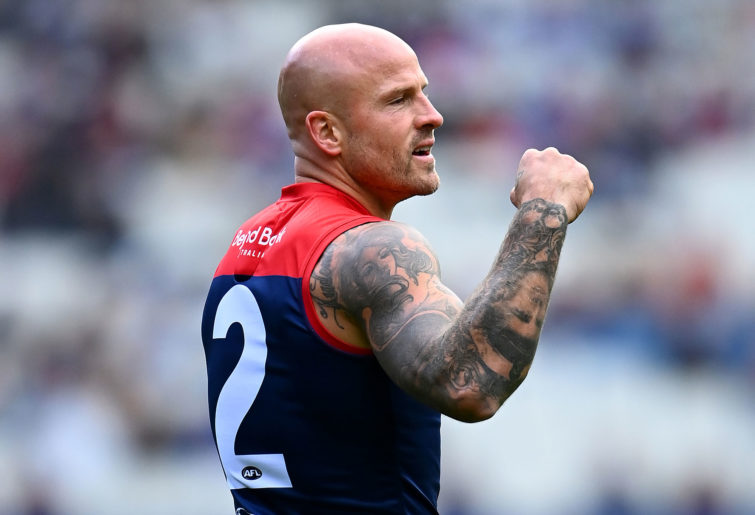
(Photo by Quinn Rooney/Getty Images)
But the Dogs have a game at Geelong, and there are a couple of games where they could be vulnerable. And every other team have already had three or more losses, so despite the impediments in front of them, Melbourne are likely to still be on top of the ladder come Round 15.
It’s worth noting that the top nine teams on the ratings scale are also the top nine on the ladder. And with the Giants having Richmond, West Coast and Brisbane over the next three weeks, Fremantle facing Port and the Dogs in consecutive games, and the Saints having Geelong and the Dogs in Rounds 9 and 10, it’s increasingly likely that the final eight are already in place.
In a previous article, I discussed the implications of several of the expected records – Melbourne’s unpredicted rise to the top of the ladder, Collingwood’s unexpected collapse, and Essendon’s coincidental string of eight games where they were slight underdogs in most cases until their meeting with Freo this weekend.
But it is curious that the Dogs, Power and Cats have all been expected to win uniformly – and for the most part have done so – but the other two common favourites beyond those top four are only hanging on to the top eight at the moment by the skin of their teeth, in seventh and eighth.
Both clubs have the Giants and Crows in the next three weeks – not a trivial pair of opponents — but they’ll be favoured to win each. If they do, that separation below them will appear and dampen the competitive questions going into the bye weeks.
Let’s take a closer look at the ratings and what they can tell us about the history and destiny of the teams in 2021.
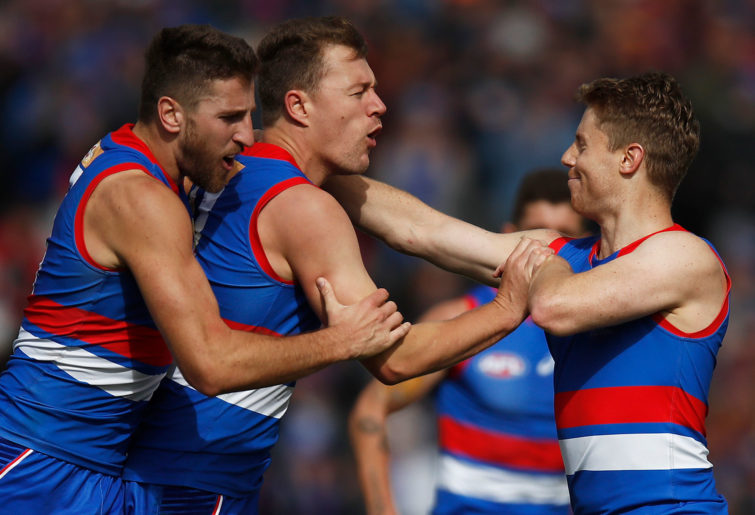
(Photo by Daniel Pockett/Getty Images)
The Bulldogs started the season with the fifth highest rating – and most experts had them in that neighbourhood on their season forecasts – but ascended to the top with their 128-point demolition of the Kangas in Round 3, the first of four straight games where they gained rating points. They have a slightly higher rating today than they did in Round 4 (68.8 to 70.7).
Geelong started second (behind Richmond) and somehow are currently second despite a 2-7 record versus the rating (they’ve lost points in seven of nine games). Those two wins against expectations were the 97-point defeat of a favoured Eagles team in Round 6 and a 63-point flattening of the defenders in Round 8, which were games that added a combined 18.5 points to their rating. Their rating had sunk from 67 to 53 but is back up to 70 coming into Friday’s game with St Kilda, which lost one tenth by being very slightly worse than ratings expectations.
Further down the ladder, West Coast and GWS have both moved up a few points over the course of the first eight rounds, as have Carlton and Gold Coast. Collingwood and Hawthorn have both fallen more than a dozen points, even before Saturday afternoon’s games.
Despite a season-opening burst from 32 up to 40 for Adelaide, the Crows have now dropped to 28.8 through eight rounds. Essendon’s net change has been positive, but only because of their Round 3 destruction of St Kilda. Meanwhile, the Saints lost almost 20 points, falling to 36 before rebounding over the last two rounds back to 46.7 after Round 8.
Finally, it’s worth noting that while the Kangas continue to linger in last place on the ratings as well as on the ladder, their victory on Saturday afternoon over the fading Hawks was also their third straight game – and fourth out of the last five – outperforming rating expectations, raising their rating from a low of 8.1 to its post-Round 9 level of 16.7, within eight points of Hawthorn and not much more behind Adelaide in 16th.
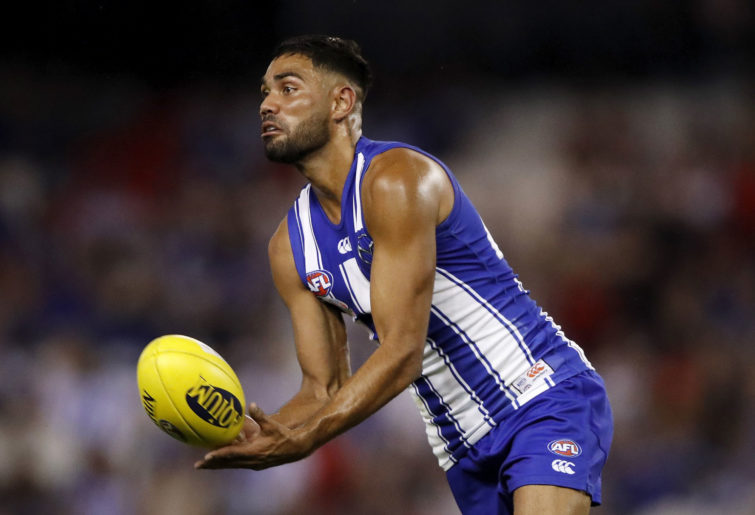
(Photo by Dylan Burns/AFL Photos via Getty Images)
The last thing we’ll look at is the sum total of the individual vote getters for each team through eight rounds. In parentheses, I’ll be including the team’s ranking after Round 4, which was the last time we checked on this statistic.
1. Melbourne Demons – 1823 points (was a not-that-distant third).
2. Western Bulldogs – 1731.5 points (was a close second).
3. Port Adelaide Power – 1604.5 points (was fifth).
4. West Coast Eagles – 1547.5 points (was sixth).
5. Geelong Cats – 1536 points (was in a pack in 11th).
6. Sydney Swans – 1518 points (was in first place – remember they were 4-0).
7. Brisbane Lions – 1419.5 points (was a distant 17th at the time).
8. Carlton Blues – 1394 points (was seventh).
9. Essendon Bombers – 1330.5 points (was eighth).
10. GWS Giants – 1329 points (was in 12th).
11. Adelaide Crows – 1323.5 points (was fourth).
12. Gold Coast Suns – 1316 points (was in 13th).
13. Richmond Tigers – 1295 points (led a pack in tenth).
14. Fremantle Dockers – 1265 points (was 15th).
15. St Kilda Saints – 1263 points (was 14th).
16. Collingwood Magpies – 1159.5 points (was ninth).
17. Hawthorn Hawks – 1107.5 points (was 16th but just 16 points behind tenth).
18. North Melbourne Kangaroos – 945.5 points (was 18th).
It’s interesting to see the sum of the individual totals mirror the ladder as closely as it does, with the Demons, Bulldogs and Power matching their fixture positions here as well. So do the Magpies, Hawks and Roos on the other end.
I’ll be back to re-examine these statistics in about a month.

































































































